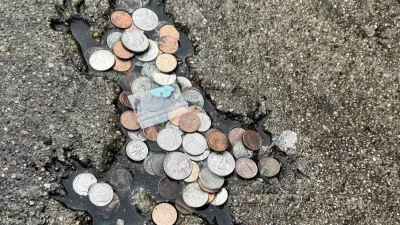Because of President-elect Obama’s plans to spend billions of dollars on infrastructure, some recent discussion of smart growth has focused on proposals for huge projects, such as rebuilding America’s rail network. But walkability often depends on much smaller steps, steps that require changes in tiny increments of space.
Because of President-elect Obama's plans to spend billions of dollars on infrastructure, some recent discussion of smart growth has focused on proposals for huge projects, such as rebuilding America's rail network.
But walkability often depends on much smaller steps, steps that require changes in tiny increments of space.
For example, take a typical tree-lined, upper-class suburban neighborhood, such as the fancier blocks of Atlanta's Buckhead. A four-foot wide sidewalk, although not ideal, can make such a neighborhood very pleasant and walkable. (For an example, see http://atlantaphotos.fotopic.net/p14704743.html )
Now substitute a strip of lawn for the sidewalk. (For examples, see http://atlantaphotos.fotopic.net/p44263562.html and http://atlantaphotos.fotopic.net/p14008023.html ) The neighborhood is not so inviting to pedestrians; although it is certainly possible to walk on this strip of lawn, the lawn can be muddy in rough weather, and a pedestrian might feel uncomfortable walking on something that is not obviously public space. Nevertheless, a city that cannot afford to build new sidewalks would be well advised to encourage homeowners to allow a small easement on their lawn for pedestrians, since the lawn strip is better than the alternative, which is
Nothing. In much of Atlanta, homeowners allow trees and bushes to go right up to the street, rather than flanking the street with lawns. (For an example, see http://atlantaphotos.fotopic.net/p14010314.html ) As a result, pedestrians must walk on the street, sharing that street with vehicles.
In sum, the fate of one or two strips of land just four feet wide makes the difference between a reasonably walkable residential street, a somewhat pedestrian-unfriendly street, and a street that virtually excludes pedestrians.
Even in the latter situation, a few feet makes a difference between the worst possible street and a merely bad one. On many sidewalk-less residential streets, cars go 40 miles per hour, creating a very risky situation for pedestrians. By contrast, when I visited my parents' vacation house in the mountains of North Carolina, people routinely hiked in the middle of the street. Why? Because the street was narrow enough that vehicle traffic was relatively slow, thus allowing pedestrians to reclaim the street to some extent. Again, a few feet made a big difference.

Manufactured Crisis: Losing the Nation’s Largest Source of Unsubsidized Affordable Housing
Manufactured housing communities have long been an affordable housing option for millions of people living in the U.S., but that affordability is disappearing rapidly. How did we get here?

Americans May Be Stuck — But Why?
Americans are moving a lot less than they once did, and that is a problem. While Yoni Applebaum, in his highly-publicized article Stuck, gets the reasons badly wrong, it's still important to ask: why are we moving so much less than before?

Using Old Oil and Gas Wells for Green Energy Storage
Penn State researchers have found that repurposing abandoned oil and gas wells for geothermal-assisted compressed-air energy storage can boost efficiency, reduce environmental risks, and support clean energy and job transitions.

Updating LA’s Tree Rules Could Bring More Shade to Underserved Neighborhoods
A new USC study finds that relaxing Los Angeles’ outdated tree planting guidelines could significantly expand urban tree canopy and reduce shade disparities in lower-income neighborhoods, though infrastructure investments are also needed.

California's Canal Solar Projects Aim to Conserve Resources and Expand Clean Energy
California’s Project Nexus has begun generating electricity from solar panels installed over irrigation canals, with researchers and state agencies exploring statewide expansion to conserve water and boost clean energy production.

HHS Staff Cuts Gut Energy Assistance Program
The full staff of a federal program that distributes heating and cooling assistance for low-income families was laid off, jeopardizing the program’s operations.
Urban Design for Planners 1: Software Tools
This six-course series explores essential urban design concepts using open source software and equips planners with the tools they need to participate fully in the urban design process.
Planning for Universal Design
Learn the tools for implementing Universal Design in planning regulations.
Heyer Gruel & Associates PA
City of Moreno Valley
Institute for Housing and Urban Development Studies (IHS)
City of Grandview
Harvard GSD Executive Education
Salt Lake City
NYU Wagner Graduate School of Public Service
City of Cambridge, Maryland





























